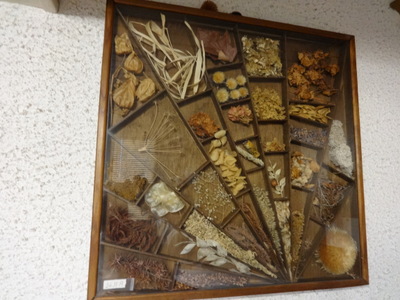 On a wall of our apartment, near the kitchen, hung this great shadow box, full of various bits of dried plant material. Way more interesting than the average shadow box.
On a wall of our apartment, near the kitchen, hung this great shadow box, full of various bits of dried plant material. Way more interesting than the average shadow box.Miscellaneous stuff
Written 5 August 2018
 On a wall of our apartment, near the kitchen, hung this great shadow box, full of various bits of dried plant material. Way more interesting than the average shadow box.
On a wall of our apartment, near the kitchen, hung this great shadow box, full of various bits of dried plant material. Way more interesting than the average shadow box.
Seen in the metro
The walls of many Paris metro stations are lined with huge boards on which equally huge publicity posters are displayed. This year's crop was especially striking. Some examples:
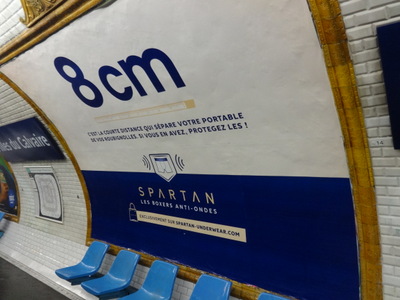
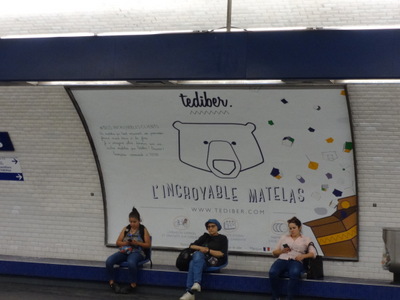 The text of on the poster at the left says, "8 cm, the short distance that separates your cell phone from your 'roubignolles'. If you've got 'em, protect 'em!" The ad is for Spartan brand radiation-proof boxer shorts.
The text of on the poster at the left says, "8 cm, the short distance that separates your cell phone from your 'roubignolles'. If you've got 'em, protect 'em!" The ad is for Spartan brand radiation-proof boxer shorts.
The one at the right advertises the "incredible 'Tediber' mattress." Now the French word for teddy bear is "ourse en pelouche" or "nounourse," but if you pronouce "tediber" in French, it comes out sounding just like "teddy bear," and the add does include a drawing of a bear. I haven't been able to figure out whether teddy bear is ever spelled "tediber" in French or whether the name of this very cuddly mattress is some sort of bilingual pun.
Another long and totally incomprehensible series of posters all ended with "just like Deezer." I finally Googled Deezer; it's a French music-streaming service. I still don't understand the ads.
And posters everywhere, especially in stairwells, said "Change occupations! Become a sophrologue!" Or that might be "sophrologist" in English. As nearly as I can figure out from what I read on line, a sophorologist is sort of like a doula but for emotionally and physically trying experiences other than childbirth, like bereavement or chemotherapy.
And cell phones work in the metro, everywhere so far as I could tell. They must have installed about a zillion repeaters down there to bring bars into spaces encased in yards of concrete, around curves in the track, and inside metal cars.
Seen in the street
Taxis in Paris now all look alike, and all are marked by an identifying number plaque just in front of the passenger-side door. Many of them are also marked "G7," and many of those are additionally marked with a little green leaf. We figured out that the leaf probably means "ecofriendly," like electric or hybrid. I initially hypothesized that "G7" was some sort of indication of fuel efficiency, but no, it turns out to be a taxi company that has taken over a large plurality of taxi service throughout western Europe.
I wondered whether the taxis have all been "municipalized" as they have in New York, but apparently not. They just don't advertise their companies or phone numbers on the cars anymore.
For some time now, Paris has had a network of bicycle rental stands. You apparently subscribe to the service and receive a code that unlocks a bicycle when you need one. You take it out of its rack, use it as needed (it comes with a chain and lock so that you can leave it locked and unattended if need be), then return it to the same or any other rack in the network. The racks tend to be empty during the day, and many more are under construction, so the service must be popular. We saw people peddling the green-painted bikes all over town.
In addition to the bicycle stands, though, they've now added electric cars to the system. There was a stand in our street that provided two different brands (about eight cars altogether). Again, you subscribe to the service and are issued a "badge" (a tap card, I think). A little automated kiosk at the curb explained the system and the step to unlocking a car. It took four or five steps—using your badge to unlock and stow the charging cable, unlocking the car itself, etc. You drive off and do your errands, then return the car to the same or a different stand. You keep paying by the hour until you have gone through the reverse sequence and plugged the charging cable back in. Slick. And at one stand, we even saw a rental electric motorcycle!
Perhaps the most surprising, not to say hair-raising!, things we saw in the street was Segway unicycles! If you read the comic called "BC," you've seen the character who rides around on a single wheel. The wheel is between his feet, and he rests a foot on each end of its short axle. Well, that's what they look like. A single wheel with a footrest on either side. No vertical stem, no handle, no nothing. We saw guys in suits zooming through Paris traffic on them (they'll go up to 25 or 30 km/hr)! Furthermore, they wore backpacks rather than carrying briefcases, because their hands were busy texting on their smartphones the whole time! As for regular two-wheeled Segways with handlebars, we saw them in only two contexts—guided tours of the city and security guards in airports and shopping malls. They don't seem popular as basic urban transport; the eunicycles seem to be slotting into that niche.
Learned along the way
More and more Paris restaurants both high- and low-end now provide menus in English or simply substitle their menus in English. (The translations are sometime hilarious.) Several times we actually had to fight them off and demand menus in French. Not only do we prefer reading about French food in French, but they're more likely to be detailed and accurate. And more and more high-end restaurants are given women menus without prices, which I find infuriating.
More and more restaurants, both high- and low-end, perhaps all of them on this trip in fact, have banished the word "porc" (pork) from their menus, calling it "cochon" (pig) instead. Again, I have no idea why. Perhaps the Academie Française has decided that, because most of the other kinds of meat in France use the name of the animal, "cochon" would be more consistent? I wonder whether "venaison" for venison will also get changed.
The French word for the "@" sign is "arobase."
Orientation for the traveler
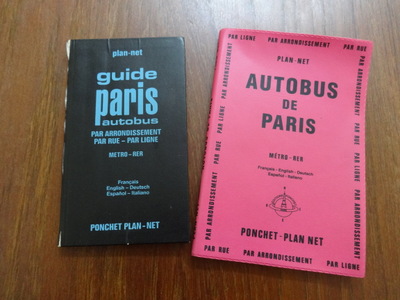
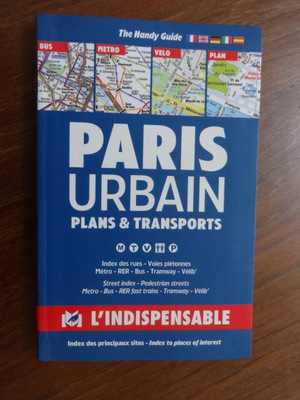 Years ago, I bought a little black book of bus routes of Paris—that's it at the left&Mdash;which also included metro and street maps, and I used it until it was falling apart. When I sought to replace it, all I could find was the bright-pink vinyl-covered version next to it, which I also used for years. This year, it was beginning to fall apart, and it was missing some important information—a few bus routes had changed, suburban trams had been added, and most important of all the #14 metro line, the Meteor, had been finished (and a couple of metro stops renamed for the occasion), and none of that was in the pink book.
Years ago, I bought a little black book of bus routes of Paris—that's it at the left&Mdash;which also included metro and street maps, and I used it until it was falling apart. When I sought to replace it, all I could find was the bright-pink vinyl-covered version next to it, which I also used for years. This year, it was beginning to fall apart, and it was missing some important information—a few bus routes had changed, suburban trams had been added, and most important of all the #14 metro line, the Meteor, had been finished (and a couple of metro stops renamed for the occasion), and none of that was in the pink book.
So this year, in the newstand at the Gare de l'Est, I found the little blue book at the right, which I highly recommend. It's called "L'Indispensable," and with good reason. Like the others, it provides a metro map, an overall bus map, a diagram of each bus route, and a street map of each arrondissement with bus and metro stops and other points of interest marked. The printing is much sharper and clearer than that in the pink book, and unlike the older ones it has added new information, even beyond being up to date with the bus routes and the Meteor: the locations of all taxi stands, tramways, bike-rental racks, one-way streets, and bike lanes. I highly recommend it.
Previous entry List of Entries Next entry